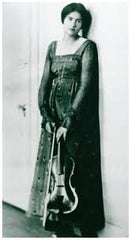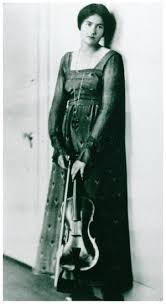 Rebecca Clarke was an English composer born in August 1886. At the age of nine, she began to play the violin, and later, during her studies at the Royal Academy of Music, she switched to the viola. She went on to make a living playing viola, and became one of the first female professional orchestral musicians. She often premiered her own compositions in solo recitals, having to use a pseudonym for some, since women were rarely taken seriously as composers. Most of her music has not even been published, or has only been recently published. As a result, the Rebecca Clarke Society was founded in 2000 to promote awareness of Clarke’s works, and has sponsored numerous world premiere performances, recordings, and publications.
Rebecca Clarke was an English composer born in August 1886. At the age of nine, she began to play the violin, and later, during her studies at the Royal Academy of Music, she switched to the viola. She went on to make a living playing viola, and became one of the first female professional orchestral musicians. She often premiered her own compositions in solo recitals, having to use a pseudonym for some, since women were rarely taken seriously as composers. Most of her music has not even been published, or has only been recently published. As a result, the Rebecca Clarke Society was founded in 2000 to promote awareness of Clarke’s works, and has sponsored numerous world premiere performances, recordings, and publications.
Rebecca Clarke’s Viola Sonata is one of her most famous works, and a staple in standard viola repertoire. She submitted the sonata to a composition competition in 1919, and it ended up tying for first place with a piece by Ernest Bloch. In the end, Bloch’s piece ended up taking home the prize, as Clarke’s victory could appear as favoritism, since the competition’s sponsor was a neighbor of hers. Many people were also skeptical of a female composer, and thought that “Rebecca Clarke” was a pseudonym for a male composer, possibly Bloch himself!
The sonata is in three movements. The first one, marked Impetuoso, opens with a brilliant fanfare from the viola. It then transitions into more Impressionistic and dream-like themes, similar to the style of French composer Claude Debussy. The second movement, Vivace, is flashier, making use of harmonics and pizzicato. The third movement starts out Adagio, then transitions into vibrant restatements of the theme.
Text taken from LIVS archives.
There are few recordings of this by well-known violists, since the piece is still relatively unknown by many. This recording of the first movement of this sonata is by David Rose, Assistant Professor of Viola at the State University of New York at Fredonia.



Leave a comment